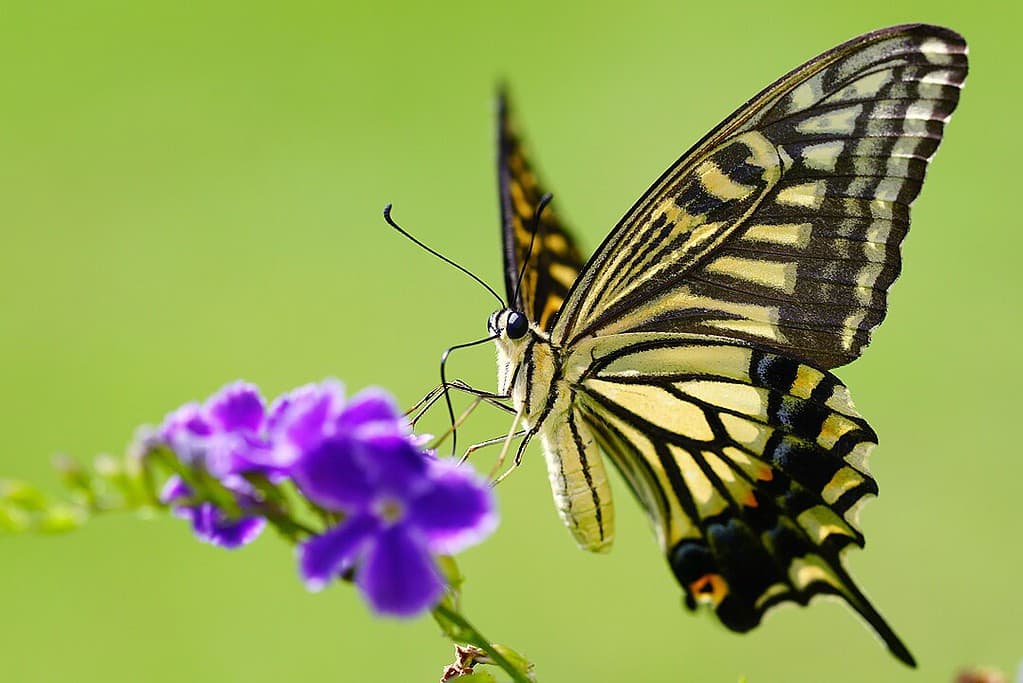For years, humans have been using animals as inspiration for creating many things we use today, from a coating based on shark skin to gloves based on geckos. This is known as biomimicry and involves learning from and then emulating nature’s forms and processes. But sometimes, biomimicry can get outright strange. Now, researchers have found inspiration in butterflies to create a new cancer imaging sensor.

Seeing ultraviolet
Humans can only detect a small portion of this spectrum. We call it, rather uncreatively, the “visible spectrum.” But there are many more parts of the light spectrum that we cannot see, either because their wavelengths are too short, or because they are too long.
Ultraviolet (UV) light is electromagnetic radiation with wavelengths shorter than those of visible light, but not as short as X-rays, for instance. Here on Earth, UV radiation mostly comes from the sun, and it presents potential risks to human health.
But in this case, UV light can be very useful, especially when combined with butterflies.
Butterflies can perceive a broader range of colors than humans, including UV light. So, researchers took inspiration from that — specifically, from the visual system of the Papilio xuthus butterfly. The team at the University of Illinois have created an imaging sensor that can see into the UV range. It can differentiate between cancer cells and normal ones with 99% confidence.
“We’ve taken inspiration from the visual system of butterflies, who are able to perceive multiple regions in the UV spectrum, and designed a camera that replicates that functionality,” Viktor Gruev, a study author, said in a news release. “We did this by using novel perovskite nanocrystals, combined with silicon imaging technology.”
As humans can’t see UV light, it’s difficult to capture UV information, especially discerning the differences between each region in its spectrum. Butterflies, however, can see these variations. “UV light is incredibly difficult to capture, it just gets absorbed by everything, and butterflies have managed to do it extremely well,” Gruev said.
The imitation game

Human vision is trichromatic, relying on three photoreceptors that combine to discern various colors through the use of red, green, and blue components. In contrast, butterflies possess compound eyes that feature six or more photoreceptor classes, each characterized by unique spectral sensitivities, the researchers explained. This is what unlocks the magic.
For instance, the Papilio xuthus, an Asian swallowtail butterfly with a striking yellow hue, not only possesses receptors for blue, green, and red, but also for violet, ultraviolet, and broadband light. Additionally, butterflies have fluorescent pigments that enable them to convert ultraviolet (UV) light into visible wavelengths.
Beyond the greater quantity of photoreceptors, butterflies also feature a distinctive tiered structure within their photoreceptor system. It wasn’t easy, but researchers were able to mimic the UV sensing mechanism found in the Papilio xuthus butterfly by using something called photonic nanostructures (PNCs).
PNCs are a type of semiconductor nanocrystal with unique characteristics akin to quantum dots. Altering the size and composition of these particles results in changes to the material’s absorption and emission properties. PNCs have recently gained popularity as an intriguing material for various sensing applications, including solar cells.
In the novel imaging sensor by the team at Illinois, the PNC layer can capture UV photons, subsequently reemitting them in the visible (green) spectrum. These reemitted photons are then picked up by the tiered silicon photodiodes. The processing of these signals enables the mapping and identification of UV signatures.
Healthcare and beyond
Cancerous tissues have high concentrations of biomedical markers, such as amino acids (the fundamental components of proteins), proteins, and enzymes, in comparison to healthy tissues. When exposed to UV light, these markers become illuminated and exhibit fluorescence in both the UV and a portion of the visible spectrum.
“Imaging in the UV region has been limited and I would say that has been the biggest roadblock for making scientific progress,” Shuming Nie, study author, said in a news release. “Now we have come up with this technology where we can image UV light with high sensitivity and can also distinguish small wavelength differences.”
Given the distinct variations in the concentrations of markers between cancerous and healthy cells, it’s possible to distinguish between these two by analyzing their UV spectrum fluorescence. The researchers then tested the capacity of their imaging device to discern between the cells and found it had a 99% accuracy rate.
They believe the sensor could be very useful during surgery. A major challenge in surgical procedures is determining the optimal amount of tissue to remove to achieve clear margins. Such a sensor can play a pivotal role in streamlining the decision-making process for surgeons when excising a cancerous tumor.
In addition to butterflies, many other species possess the ability to perceive ultraviolet (UV) light, and having a means to detect this spectrum opens intriguing possibilities for biologists. It offers an avenue to gain deeper insight into aspects of these species, including their hunting and mating behaviors, the researchers noted.
The study was published in the journal Science Advances.






